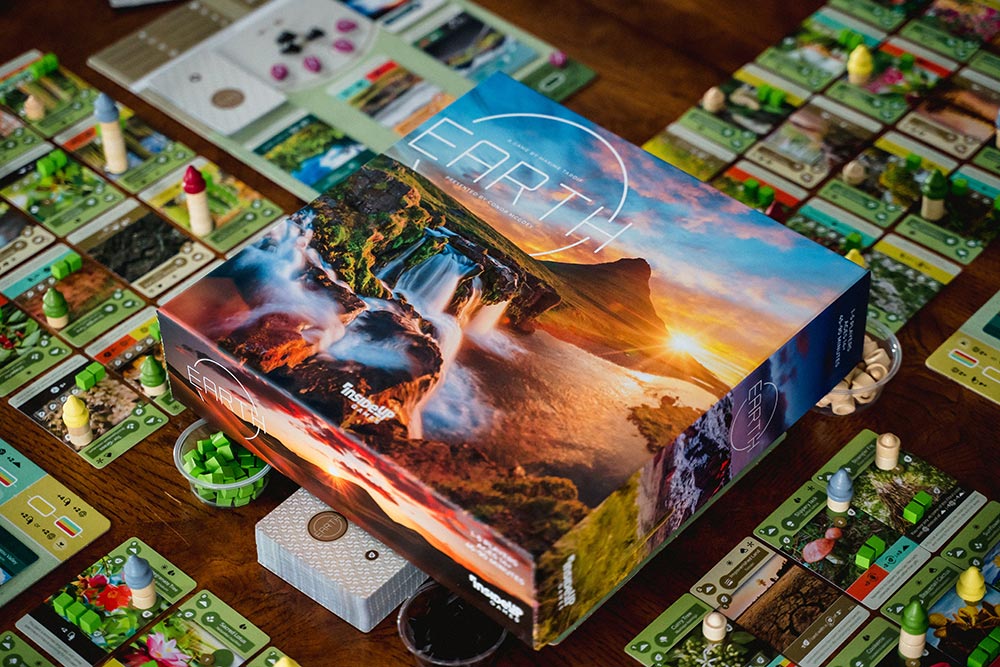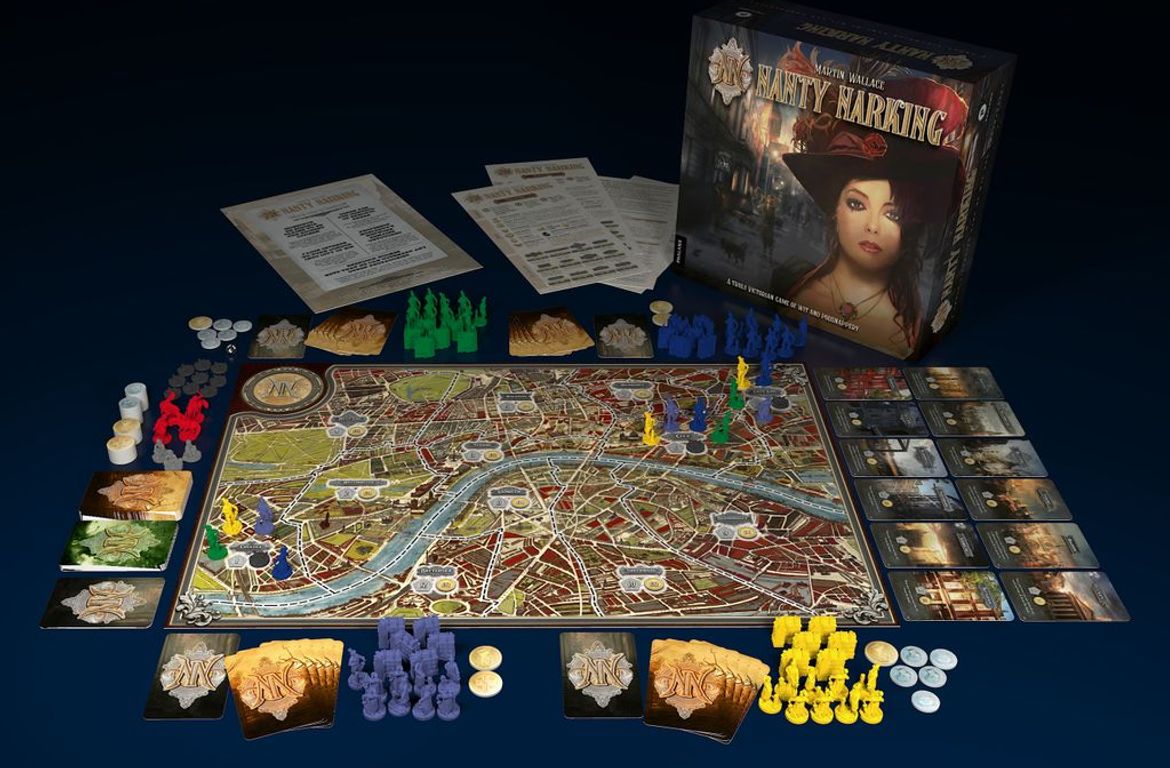
Earth: Istražite Prirodna Čuda planete Zemlje kroz Društvenu Igru
U svijetu društvenih igara, Earth se ističe kao igra koja kombinira ekološku svjesnost, strategiju i prekrasnu umjetnost. Ako ste ljubitelj
Sorting Order from Chaos
I began Tesseract accidentally in 2019 by idly stacking a large pile of dice into a cube. I was putting off packing for a trip to visit family, deciding which prototype I would subject them to this time.
Staring at the cube of dice, I realized it had a few interesting properties: If you removed a die from the cube, another die of unknown value was revealed; some dice were surrounded, making them impossible to remove, but their value was known; and surrounded dice could become accessible through the removal of other dice.
For the rest of the trip, I thought about how to turn that cube of dice into a game…
My first notes on Tesseract
From the start, I decided Tesseract would be co-operative. I didn’t have much experience with co-op games, but the potential for teamwork in the ability to “unlock” inaccessible dice excited me. Combined with the tension that multiple players might need the same die, it seemed like there would be plenty of reason to communicate and strategize as a team. The theme flowed naturally from the components. It seemed intuitive that disassembling an unpredictable structure covered in obscure symbols was akin to diffusing an alien bomb.
The prototype dice, or “cubes” as they would come to be known
Excited by the premise and searching for direction, I met up with my friend Henry. I had bought 64 wooden cubes in four different colors, then used a Sharpie to draw the die faces. We stacked them into a large cube on the dining room table as I explained all the exciting possibilities contained within. Without any gameplay to speak of, we tossed around a few ideas and settled on three core ideas:
• The players win by removing the last die from the cube of dice, now known as the Tesseract.
• Players take dice from the Tesseract to fulfill recipe cards that require specific color and value combinations.
• Something bad happens when too many dice with the same value are face up on the Tesseract.
As it turns out, none of these “core” ideas would survive to the final version of the design. At the time, I was just glad someone else saw the potential I did.
Players Win by Removing the Last Die?
The first major overhaul was to the game’s win condition. After a handful of tests, it became clear that removing every last die was a bit of a chore. Reducing the number of dice might have worked, but I was stubbornly attached to the aesthetic of the cube, so I shelved it for awhile, waiting for a solution — which occurred to me on a walk to the market: Make the players lose when the last die is removed.
Everything started to click. The stack of dice was both a resource and a timer, an unavoidable visual reminder of how close you were to the end. Players would have to think twice about taking a die they couldn’t immediately use since every extra die left in the Tesseract meant more time to win the game. A cascade of changes followed as I reworked the design from the ground up.
Players Use Dice for Recipe Cards?
Early iterations of Tesseract were overly complex and insular. Players had uniquely themed workstations with three different dice recipes that triggered bonuses when fulfilled. The challenge system revolved around forcing you to take dice you didn’t need and commit them to recipes, thereby locking up your workstations with incorrect recipes. If too many stations got locked, the players lose. It took too many tests to realize the obvious: A challenge system built around removing player’s choices left them feeling powerless and ineffective — not fun.
One of many iterations on dice recipes
The next iteration was more dynamic, allowing players to freely reassign dice and expand their repertoire of recipes over the course of the game. Along with these new freedoms came a ballooning of complexity and downtime as players churned through different sequences of actions in isolation. It was tedious and lonely. If testers hadn’t been so enthusiastic about the direction of the game, it’s likely I would have moved onto other projects entirely.
The first breakthrough came from cutting the dice recipes. Requiring players to take specific dice proved too limiting in a system where the Tesseract was stacked at random. The recipes were too prescriptive and left little room for play.
In their place, I settled on a “containment procedure”, a single universal recipe that could be fulfilled in any number of ways. Not only did this dramatically simplify the game, it allowed room for players to feel clever with their choice of dice.
The universal recipe, much inspired by the simplicity of SET
However, with one recipe, nothing would stop another player from running your turn. I worried that an alpha player would arise and dominate the game. Some say alpha gaming is a player problem; others say it’s a game problem. I was in the latter camp and wanted to design Tesseract to negate such a possibility.
However, after the first test with the new containment procedure, I changed my mind. The whole game had opened up! People began talking, strategizing, and co-ordinating. Now when a player struggled, everyone put their heads together and made a plan instead of sitting in stony silence as a lone player labored over what to do with their turn. The new flexibility created a larger decision space and a fuzzy uncertainty about what the best move could be. In a game with more possibilities than can fit in one head, allowing players to help each other was essential. Watching people play, I was reminded me why I love co-operative games: you get to discuss strategy while you play the game.
Too Many Matching Dice Cause Something Bad?
The main flaw of the original challenge system was in the upkeep. Players had to count the matching dice every time they removed one from the Tesseract. Delaying this upkeep until the end of the turn only made matters worse as players would count all the exposed dice. I happily abandoned this framework in the overhaul.
I quickly hit on the “priming” process that survived to the game’s final version. How best to use it took many, many iterations. The basics of priming were this: At the end of each turn, you remove the lowest cube in the Tesseract, then roll it into the primed area. Once primed, dice become largely inaccessible to players.
In each new version, I tried different penalties for accumulating primed dice. One version ended when nine dice were primed, which lacked drama since there was little room for surprise. Another version had players repeat the priming process if the newly primed cube had an identical match in the primed area. This could create chain reactions that were exciting, but extremely swingy.
For all their individual problems, these priming options shared a common one: There was no deeper strategy than keeping the primed area as empty as possible. The eventual solution would be an echo of the first challenge system. Progress is rarely a straight line.
Primed dice stack up in the red zone beside the Tesseract, indicating the relative danger of a breach
In the final version, a breach occurs when the third die of the same value is added to the primed area. Get seven breaches, and the players lose.
This system made it easy to tell at a glance how threatening the current situation was, and as a result, players began discussing how to balance safety versus risk. Is it worth a one in six chance of disaster to have a more efficient turn? Based on the result of a die roll, players either felt like they had taken a wise risk, or gotten punished for playing too carelessly. Either way, it had the exact kind of tension I was hoping for. Players needed a new goal to match.
The final containment board, after containing a few cubes
Containing a die of each color and value immediately clicked with players. It still had the feeling of neutralizing the entire Tesseract, but now it felt satisfying as players completed the rows and columns of cubes.
Around this stage of development, I submitted Tesseract to a speed pitching event and piqued the interest of Curt Covert of Smirk & Laugher Games. After a quick playtest (we lost horribly), Tesseract was signed, and we began the massive undertaking of balancing the game.
Finishing Touches
Early in development, Tesseract was nightmarishly difficult. Balance was skewed to give me and veteran players in my test group a run for their money. Rather than making the game significantly easier, we generously boosted the power level of a player’s role cards, attempting to give them each tools that felt overpowered. As a result, each player’s unique contributions became essential to the success of the team. The other major lever for balance was something Curt had been suggesting since the beginning: new threat events.
We brainstormed new ways the Tesseract could lash out at players as they chipped away at its defenses and settled on a set of events that ranged from annoying to devastating. Changing the distribution of these events gave us the ability to fine tune each difficulty level, ensuring players could find the challenge that suited them.
The whole process took the better part of a year. By the end, it was hard to keep straight how one version compared to the last, but after an excellent reception at an Unpub event in Baltimore, we were both pretty sure Tesseract was finished.
Then, it was time to talk about art.
The final prototype played at Unpub; even at its most printer friendly, the stack of colorful cubes drew tons of interest
I remember describing my vision of Tesseract to Curt: a fusion of near-future sci-fi and retro-minimalist design. When he showed me Denis Freitas‘ work, I couldn’t believe he had found someone so perfect. Denis’ character illustrations bring so much life and personality to the game that it’s hard to imagine Tesseract without them.
Many of the game’s final graphic elements are my own, developed in parallel with the game’s systems. The clean lines and round pips of the original dice designs informed the look and feel of the rest of the game, while I took inspiration from circuit diagrams and monumental architecture for the boards and dice stand.
Early teaser art for the Quantum Mechanic, one of the game’s eleven unique role cards
Without the generous feedback and encouragement of numerous playtesters, Tesseract would never have made it this far. Weekly tests with a small group of dedicated, enthusiastic friends made the game what it is today. Their feedback paved the way for each new breakthrough in the design process. I have Curt to thank for his countless solo tests and exciting ideas for how to introduce greater texture and variety to the game.
What began as a pile of dice on my desk turned into a passion project that kept me sane throughout the pandemic. When lockdowns started, online testing exploded. I found community with friends and fellow designers hundreds of miles away and learned an incredible amount in the process. If players enjoy Tesseract even half as much as I enjoyed designing it, that’ll be a win in my book.
The final game, set up for two players; the dice stand was one of Curt’s many great ideas

U svijetu društvenih igara, Earth se ističe kao igra koja kombinira ekološku svjesnost, strategiju i prekrasnu umjetnost. Ako ste ljubitelj

U svijetu društvenih igara, rijetko koja igra uspijeva obuhvatiti bogatstvo povijesti, strategije i priče poput Nanty Narkinga. Ova igra, smještena